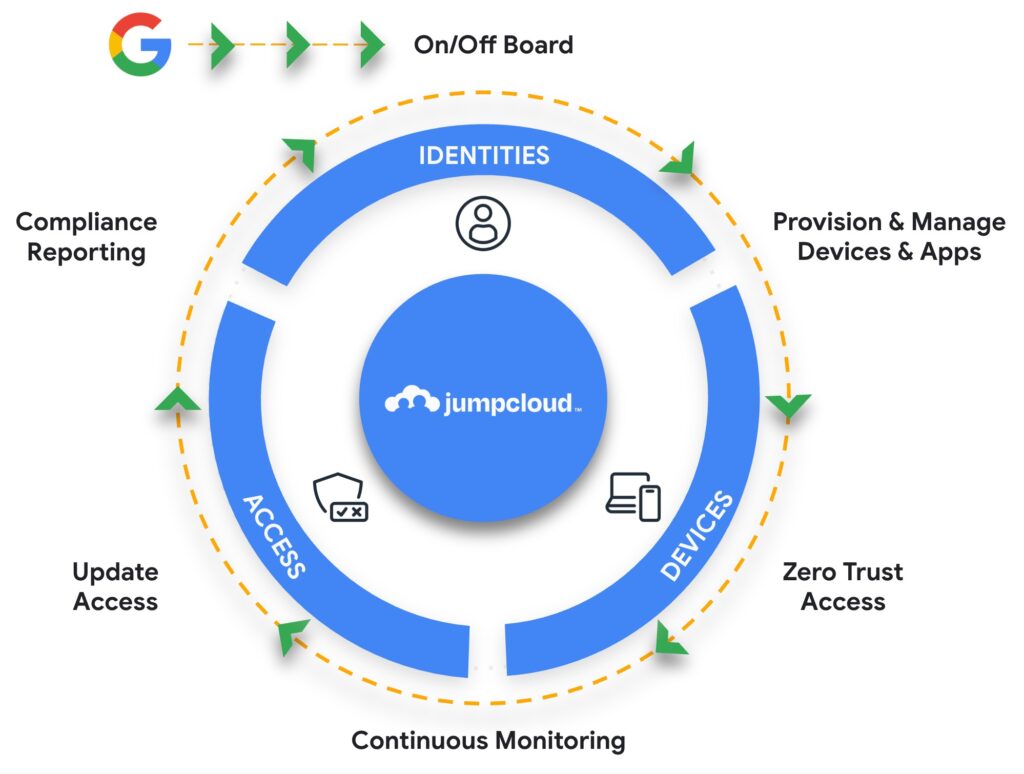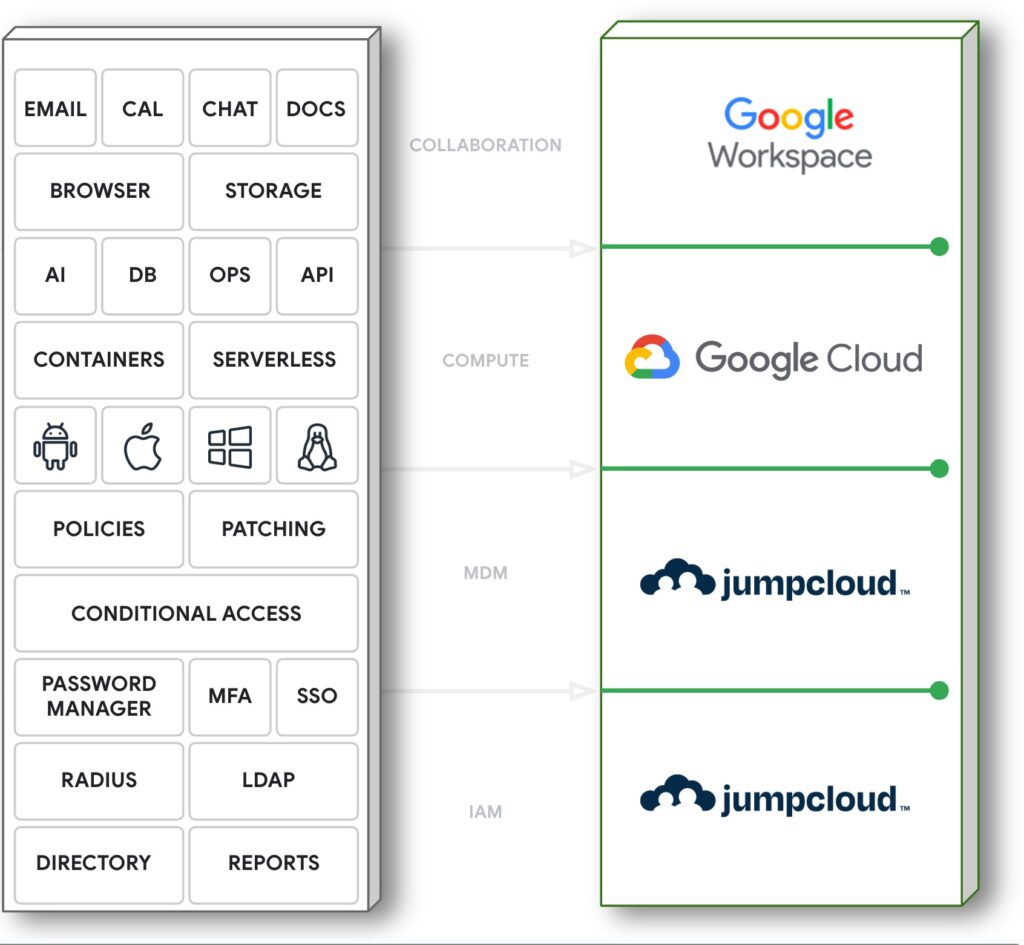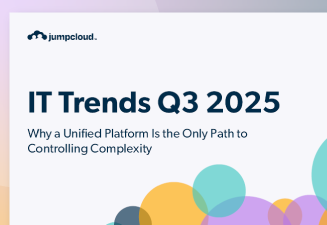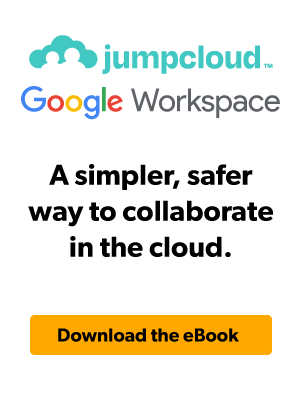Un-Stuck Your Stack with JumpCloud and Google Workspace
5 Reasons Why You Need A Modern Approach
There comes a time in every IT professional’s career when they wish they could crumple up their entire IT stack and throw it in the trash.
Realistically, you’ve probably felt this way more than once.
That’s because many of the tools that make up the average IT environment were designed a long time ago, and they don’t interface well with each other. They were designed to support homogenous technology stacks, managing a fleet of homogenous devices and applications, in an office-setting that rarely extended further than the local network.
That makes managing your stack today a pain.
You feel stuck with it, and you end up doing whatever it takes to make it do all the things your company needs it to. As the requests pour in — Marketing wants Macs, your CEO won’t stop accessing sensitive docs with their Android, and everybody wants AI for everything — you end up tacking things on and doing backbends to make everything work.
One day, you wake up tied in knots and want to throw it all away and start fresh.
You can’t do that, for obvious reasons.
But there is a solution.
Get Un-Stuck With JumpCloud and Google Workspace
There are modern solutions built to address these issues.
They work with modern productivity tools, like Google Workspace (GWS), that were built from the ground up to be cloud-first, flexible, scalable, and secure.
And they work with all the other tools you need in your stack. That means:
- Managing every device type, no matter who owns them.
- Providing secure access to every application, whether you host it or someone else does.
- Allowing someone to work from any office scenario, whether they work from home, the office, or a shared space.
This agnostic design releases you from vendor lock-in and allows you to simplify the complexity that’s been accumulating.
If your IT management solution is designed to integrate with open platforms like Google Workspace and support vendor-agnostic programs for managing access, devices, and more, you can accommodate the tools you need to make work happen the way you want it to. This gives you the flexibility to choose the tools that work for your organization, while powering centralized IT management and enabling productivity. The end result is strategic agility: you have the means to adapt freely and invest in the changes that make the most sense for your organization.
JumpCloud is exactly that type of IT management solution.
JumpCloud delivers a unified identity, device, and access management platform that makes it easy to securely manage identities, devices, and access across your organization. It’s cross-OS capabilities mean your fleet can be as diverse as your people need it to be, while it’s expansive ID federation features allow you to originate identities from different sources but manage them with a unified view.
With Google Workspace and JumpCloud, you can:
- Connect—anywhere, anytime, using a trusted device with one secure identity
- Cut complexity and costs as you unify identity, access, and device management
- Streamline onboarding and rapidly provision users across apps, devices, and networks.
- Simplify Zero Trust security so you can grant access to what your users need and nothing they don’t.

It’s time to dive into the driving force behind the challenges you’re facing, the modern solution designed to combat these challenges, and how to solve for them in your environment.
Keep reading to get unstuck!
The Traditional Approaches And Their Negative Effects
When it comes to managing your stack, it can feel like you’re stuck between a rock and a hard place.
The Rock
Using an inflexible, legacy single-vendor solution, such as Microsoft.
→ You ←
The Hard Place
Piecing together fragmented point solutions from a variety of vendors.
Neither is ideal.
Many companies start with The Rock. They adopt a vendor like Microsoft and go all-in on that ecosystem.
But as they grow, their needs diversify. Which brings them to The Hard Place. They need more solutions than their main vendor can offer, so they start adopting point solutions. These multiply quickly and create a sprawled ecosystem that’s hard to work with.
While these two challenges can feel like opposites (being stuck with one tool versus stuck with too many), they’re the same in the ways that they hold you back:
- Lack of flexibility. These challenges can lock you into certain solutions and out of others. It makes it hard to power growth and adapt to change.
- Built-in preferences. Instead of taking an agnostic approach, both challenges are dependent on certain operating systems, software, or vendors. They’re prescriptive in the way you run your environment, which puts you in the passenger’s seat.
- Security issues: Both challenges create security blind spots, due to either things slipping through the cracks in a complex environment or shadow IT as employees look for workarounds in rigid environments.
- Inefficient management: Neither option allows you to build the environment you want, and both end up shaping the way you have to manage your stack. This reduces efficiency and puts strain on your team.
- Outdated technology: Many of the vendors that lock you in rely on legacy equipment and antiquated frameworks.
You feel stuck. The uniting element here is the feeling of “stuckness.” You’re stuck working the way vendors want you to and unable to shape your own environment.
Why Change Now?
Making a change can feel like a heavy lift. If things haven’t completely blown up, it can be tempting to continue with the status quo.
But these challenges won’t go away. They’ll only get worse. And they have trickle-down effects that do more than give you and your team a headache:
- They hamper your organization’s ability to grow. When it’s hard to make changes and adopt new tools, you’ll avoid doing it. The result? You become the roadblock between your company and its goals. Not a great place to be.
- They create security vulnerabilities. When your stack is made up of a bunch of different puzzle pieces that don’t fit together all that well, you end up with gaps. These gaps are caused by a lack of visibility and control over all the pieces in your environment.
- They lower productivity. When you can’t configure your environment the way you want to, users and IT alike feel the effects.
- They make compliance much harder. When you don’t have clear visibility into everything in your environment (whether that’s due to multiple point solutions or shadow IT), it becomes hard to prove compliance when you need to. You could be in violation without realizing it.
Conversely, if you’re stuck in a monolithic environment where one vendor reigns supreme, it becomes difficult to accommodate the other tools your employees need to succeed. But rather than effectively preventing employees from using these tools, you’re more likely to be dealing with a mountain of shadow IT that you can’t see or mitigate.
Investing in a modern solution mitigates these risks while setting you up to enable your company’s success rather than hinder it.
The Modern Alternative: JumpCloud and Google Workspace
It may feel like there are only two paths forward. But there’s a third option that’s the best of both worlds: JumpCloud and Google Workspace.
The core of JumpCloud and Google Workspaces’ infrastructure vision lies in modernity and vendor-agnosticism.

This is in response to the lose-lose options most companies feel stuck with. These solutions are built to do the opposite of locking you in: they’re designed to work with whatever vendors you want to work with, and they’re modern and cloud-based, which makes them flexible enough to work the way you want to. Centering your stack around a few core tools that can do this will empower you to work the way you want to, instead of restricting you to working the way the vendor wants you to.
One tool used in an IT environment should never dictate exactly what else can or cannot be used — that’s for each organization to decide.
How Does JumpCloud and Google Workspace Work Together?

- Sync Workspaces and HRIS platforms to easily manage new users
- Extend Workspace identities as the primary account for accesses IT resources
- Scheduled activations and deactivations for smooth onboarding and offboarding
- Dynamic access based on groups and conditions
- Enhanced SSO access to 900+ applications
- Phishing-proof passwordless access using biometrics
- Sync Workspace identities across multiple device types
- Deploy, manage, and patch Chrome across your fleet
- Out-of-the-box device security and access policies
- Report across users, access, and resources for auditing and compliance
- API driven features for automated workflows & discovery for organizations of any size
5 Benefits of a Modern Approach
The combined power of JumpCloud and Google Workspace set you up to tackle the challenges of today’s dynamic environment. With its focus on flexibility and scalability you’ll be able to realize the following benefits:
JumpCloud can extend Google Workspace identities to the resources that users need to get work done. This unified identity and access approach gives employees a single identity to access all of their resources, including their productivity suite, which reduces the security risks of having multiple identities per user.

With a modern setup, you can add security layers — like single sign-on (SSO), multi-factor authentication (MFA), and conditional access — to all instances of authentication. This prevents Google Workspace and other third-party applications from sitting outside of your control, or being exceptions to your security rules.
Unlike traditional solutions, these layers of security don’t hinder the user experience. They make it easy for users to access everything they need to be productive, regardless of the type of device they use.
The other benefits you enjoy with modern solutions have trickle-down security benefits. We’ll point out these security wins as you read on.
The rigidity of traditional IT management approaches makes it hard for you to enable work the way you want to.
By contrast, JumpCloud and Google Workspace do the opposite: they’re built to be flexible so that you can configure your environment the way you want to. They can be agnostic to vendor and OS, which means you can support users by enabling the devices and solutions they prefer to work with.
Flexibility means:
- Future-proofing: When it’s easy to integrate with other tools and make changes to your environment, you’re free to grow and adapt to change however you need to. This prepares you to accommodate whatever comes your way.
- Scalability: Easily adapting to change makes it easier to grow and scale.
- Security: Enabling users to work with the devices and solutions they prefer reduces shadow IT. Maintain visibility and control, regardless of how they work.
- Higher productivity: When users can work the way they want to, they’re positioned to succeed. This means higher productivity and user satisfaction.
- Easier IT management: Flexibility makes integration with other tools easier to configure and manage.
Flexibility helps you reduce shadow IT by accommodating the tools employees prefer. To learn more about how you can combat shadow IT, check out Casting IT into the Shadows.
JumpCloud allows you to centrally manage the user lifecycle, from onboarding to offboarding all directly integrated into Google Workspace. Users maintain one login for all of their resources. This combined approach enables you to:
- Automate workflows and rapidly provision and deprovision access.
- Ensure changes made in one place are reflected across all connected resources.
- Manage access to all resources, including Google Workspace, in one place.
- Automate onboarding and provisioning, including granting access to productivity suite.
- Quickly offboard users and revoke access from all tools, including Google Workspace.
Make sure users maintain the right levels of access to all resources, including Google Workspace, and immediately revoke access to all resources upon an employees departure (even when they’re remote).
The flexibility and agnosticism of JumpCloud and Google Workspace allows you to bring your identity, access, and cross-OS device management efforts for everything under one roof. Whether you’re solving for vendor lock-in or vendor sprawl, a modern solution to IT management allows you to incorporate the tools you need into your stack smoothly.
A modern approach dramatically simplifies your environment (without sacrificing robustness or functionality). It can also help you cut down on costs over time by reducing point solutions and investing in the tools that best fit your budget and functional needs.
The more point solutions you have, the more likely you are to have blind spots. Simplifying and consolidating brings everything back into your line of sight.
All these benefits culminate into a significantly more efficient (and enjoyable) IT management experience for your team. JumpCloud and Google provide holistic views into your environment that grant complete visibility into user access privileges and device posture from a single pane of glass. This translates to:
- Reduced troubleshooting time: When your team can see everything in a single pane of glass, getting to the root of an issue becomes so much easier.
- Simplified compliance: Comprehensive visibility and control over your entire environment takes compliance from a piecemeal nightmare to a streamlined experience.
- Reliable security: Centralized visibility into all your resources reduces blind spots and allows your team to ensure security with confidence.
- Easier changes: Making changes when your environment is well-integrated is easy. Configurations become less manual, and changes automatically take effect everywhere.
Comply with audits easily and quickly spot and rectify any instances of non-compliance, which reduces blind spots and improves security.
Power Strategic Agility
If you feel stuck with your stack, take comfort in knowing it’s a common problem — and that there’s an accessible solution.
JumpCloud is the modern IT management platform that can integrate with the tools you want, including Google Workspace. It’s designed to allow you to configure your environment however works best for your organization. They integrate with other tools and don’t lock you into one vendor’s processes or toolset.
The all-too-common challenges with vendor lock-in and tool sprawl were foundational reasons why JumpCloud was created.
In response to these issues, JumpCloud was designed to be a cloud-based identity, device, and access management platform that’s agnostic to operating systems and devices. It integrates with Google Workspace so you can extend your identity and device management programs to it and layer authentication with SSO, MFA, and conditional access policies.
JumpCloud is also device agnostic and designed to work well with other vendors. This allows you to enable users on whichever devices they prefer (including Mac, Windows, Linux, Android, and iOS) and adapt whichever solutions you need to power work in your environment, whether that’s Google Workspace, M365, or a custom combination of tools. This helps you avoid vendor lock-in, regardless of your productivity suite or identity services provider.
If you’re ready to see for yourself how JumpCloud and Google Workspace really make it happen, connect with a JumpCloud expert to talk through your stack and see exactly how you can un-stuck it. Or, check out our library of interactive demos to see the product as you would experience it live.
Explore our personalized, interactive JumpCloud experience, tailored to your priorities.
Try It TodaySign up for a personalized demo with a JumpCloud expert to see how you can conquer your IT challenges.
Sign Up Now


